 |
Closer Look
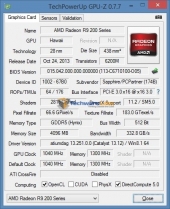 |
To start off we’ll take a look at the GPUz of the 290X. We can see here that the card has 2816 shaders, 786 more than the outgoing 7970. We also get a 512 bit bus (vs the 7970’s 384 bit), 4 GB of GDDR5, and a core clock of 1040 MHz. These specs are mighty impressive, we’ll see if it translates to performance in our benchmarks.
 |
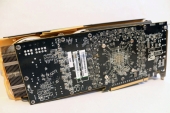 |
So the first thing you notice when you look at the 290X Tri-X is the cooler. These 290Xs are known to run hot and there have been reports of the stock cards throttling themselves down because of excessive temperatures on the stock cooler. Sapphire solved this problem by designing a high performance triple-fan setup to help dissipate the enormous enormous amount of heat this card puts out.
Looking around back we see that the cooler actually extends over the back of the board about an inch, bring the total length to a whopping 12 inches. You better take some measurements before attempting to fit this bad boy in your case.
 |
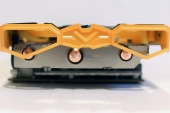 |
While this style of cooler is able to keep the GPU very cool, the big drawback compared to the blower style is that the heat from the GPU is blown right back in to the case rather than exhausted out the back. This means that case cooling becomes very important in order to remove all that extra heat and keep it away from the other components.The major key to the Tri-X cooler, aside from the fans, is the heatpipe system. Sapphire has employed an assortment of different sized heatpipes that snake across the card and through the large fins in order to quickly draw the heat away from the critical areas.
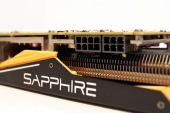 |
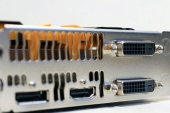 |
Like all high-end graphics cards, the 290X requires two PCI-E power connectors, an 8-pin and a 6-pin.
In the rear we see all of the different outputs. You get one HDMI (with 3D), one DisplayPort 1.2, and two Dual-Link DVI-D. With the new Hawaii architecture in the 290X, it is no longer required to have a DisplayPort monitor when running Eyefinity. So you can run a triple monitor setup out of the box with no special adapters or expensive monitors.
Temperature
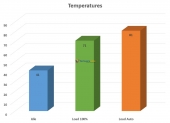 |
Now that we’ve seen the new cooler, how does it actually perform? At idle with the fan at auto (20%) the card runs at around 41 C which isn’t too bad. Under full load in FurMark we got 71 C with the fan at 100% and 81 C with it on auto. These temps are a pretty large step up from the previous gen cards, but the Tri-X cooler was able to still keep it fairly reasonable.
Noise
Considering how well the Tri-X cooler keeps the temps reasonable on such a powerful card, the noise levels are pretty impressive. At idle the card will sit at 20% and is inaudible. Ramping the fan up to around 50%, the fans become audible, but still very quiet. As you bring the speed higher and higher the sound seems to increase quickly. At 75% it is atleast twice as loud as 50%, but still not too bad. Maxing it out at 100 definitely makes it the loudest thing in the case, but it is still quite bearable.
The “Auto” setting was pretty lax, letting the card get pretty warm before ramping up the fan speed which helps keep it really quiet. When gaming, I preferred to just max the fan out so it ran as cool as possible, and after a minute or two it just gets zoned out. It’s still miles better than any conventional blower style cooler out there.

[…] Sapphire R9 290X Tri-X Edition Review @ TechwareLabs.com […]
[…] Sapphire R9 290X Tri-X Edition Review @ TechwareLabs.com […]
[…] Sapphire R9 290X Tri-X Edition Review at TechwareLabs.com […]